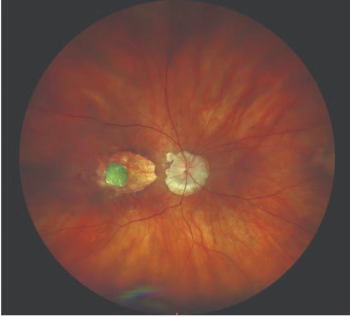
- Modern Retina Fall 2024
- Volume 4
- Issue 3
The future of retina care
Retina is a rapidly advancing field with promising research, technology, and treatment areas. Two stand out as particularly exciting.
Marta Stevanovic, MD, MSc, received an inaugural Visionary in Eye Care Resident Recognition Award at EyeCon 2023.
Retina is a rapidly advancing field with promising research, technology, and treatment areas. Two stand out to me as particularly exciting.
GENE THERAPY
Gene therapy has been investigated for several inherited conditions but is particularly promising for treating retinal disease. The retina is amenable to therapeutic interventions because it is small, contained, and considered to be immune privileged, which means that immune
responses are relatively suppressed.1
Gene therapy for ocular disease has relied mainly on gene replacement or augmentation, in which a copy of a gene is injected into the eye.2-6 This approach is employed for diseases in which a functional copy is missing. Typically, gene therapies are packaged into adeno-associated viral vectors (AAVs) or lentiviruses, which are then delivered to the eye, usually by injection into the subretinal space. The first FDA-approved gene therapy for a genetic disease was voretigene neparvovec-rzyl (Luxturna; Spark Therapeutics). Voretigene neparvovec-rzyl is a viral vector that delivers a normal copy of the RPE65gene packaged in an AAV.2,3 It has shown long-term safety and efficacy.2,3 Several clinical trials using gene replacement have studied other inherited retinal degenerations (IRDs) like X-linked retinitis pigmentosa, choroideremia, and Stargardt disease.4-6
Although delivering a functional copy of a gene can potentially treat loss-of-function mutations, editing DNA could treat dominant mutations, in which suppression or inactivation of a gene is required. Recently, a
phase 1/2, open-label, single-ascending-dose study, BRILLIANCE (NCT03872479), was conducted using EDIT-101 gene therapy to treat CEP290-associated retinal degeneration.7 EDIT-101 uses clustered regularly interspaced short palindromic repeats (CRISPR) and CRISPR-associated protein 9 (CRISPR-Cas9), which function as a type of “molecular scissor” that excises the pathogenic CEP290 IVS26 variant.7 In BRILLIANCE, EDIT-101 had a good safety profile and improved best corrected visual acuity, red light sensitivity, and vision-related quality of life in a subset of patients.7 The results of these studies are promising, and I am excited to see CRISPR-Cas applied to treat other pathogenic mutations.
I believe there will be many advances and refinements in gene therapy methodologies, particularly in CRISPR/Cas gene editing. Other promising approaches include CRISPR/Cas base editing, RNA editing, RNA interference, and translational readthrough-inducing drugs. Advancements in delivery could also improve the efficacy and ease of administration of these interventions. Currently, retinal gene therapies are primarily injected into the subretinal space. Subretinal delivery can be technically challenging. In the future, delivering gene therapy intravitreally or into the suprachoroidal space may be an alternative and more straightforward approach.
Although IRDs are an obvious target for gene therapy, other diseases like age-related macular degeneration (AMD) and diabetic retinopathy may benefit from this intervention as well. The mainstays of treatment for neovascular AMD and diabetic retinopathy are intravitreal anti-VEGF injections. This approach, however, often requires repeated injections. Creating a gene therapy that causes sustained suppression of VEGF would obviate the need for multiple administrations of anti-VEGF therapy.8
ROBOTIC AND ELECTRONIC DEVICES
The fourth industrial revolution is upon us, and I am excited for how it will shape vitreoretinal surgery. In particular, the use of electronic and robotic devices holds incredible potential for treating vision loss, restoring vision, and improving the quality of life for patients.
Bionic eyes are bioelectronic devices that are implanted into the eye and can restore vision. Several retinal implants have been developed to treat vision loss from IRD. The Argus II (Second Sight Medical Products) is the only epiretinal implant approved by the FDA.9,10 Many other implants have been tested, including the IRIS II (Pixium Vision) and retina implant Alpha II AMS (Retina Implant AG), which received approval in Europe.11,12 Electronic implants are still in their early stages but are a promising option for patients with retinal disease. I look forward to future developments in electronic implants, including improvements in microelectrodes, processing algorithms, and camera modules.
Robotic surgery is another field that will change how retinal diseases are treated. Retinal surgery requires great precision. Several innovations, either surgical devices or robotic systems, have been developed to assist during vitreoretinal surgery and address the limits of human dexterity. Handheld devices, like the Micron and SMART (Smart Micromanipulation Aided Robotic-surgery Tool) microforceps, can reduce microtremors through active compensation.13-15 Cooperative control systems, like the first- and second-generation Eye Robot, are devices in which the surgeon and robot hold and control the surgical instrument, allowing for the cancellation of surgeon tremor.16,17 The teleoperated robots are characterized by an input device controlled by the surgeon and an actuator device, which controls the surgical instrument. The teleoperated robot that has received the most attention is the Preceyes, designed to provide superhuman precision during surgery; it has been successfully used to assist with membrane peeling in a clinical trial.18 The final category of robotic devices involves the untethered microrobots. These devices can be controlled wirelessly, like the I2RIS, or via an external magnet system, like the OctoMag.19,20
The nascent field of retinal robotics is exciting. I expect it to develop significantly during my career and allow for improved surgical techniques and treatments. These robotic devices can be further enhanced through integration with intraoperative imaging, such as optical coherence tomography and artificial intelligence.
The future of gene therapy and electronic and robotic devices in treating retinal disease is bright. I foresee significant advancements in precision and efficacy, ultimately allowing for better treatments for patients and improved quality of life. •
REFERENCES
1. Zhou R, Caspi RR. Ocular immune privilege. F1000 Biol Rep. 2010;2:3. doi:10.3410/B2-3
2. Maguire AM, Russell S, Chung DC, et al. Durability of voretigene neparvovec for biallelic RPE65-mediated inherited retinal disease: phase 3 results at 3 and 4 years. Ophthalmology. 2021;128(10):1460-1468. doi:10.1016/j.ophtha.2021.03.031
3. Maguire AM, Russell S, Wellman JA, et al. Efficacy, safety, and durability of voretigene neparvovec-rzyl in RPE65 mutation–associated inherited retinal dystrophy: results of phase 1 and 3 trials. Ophthalmology. 2019;126(9):1273-1285. doi:10.1016/j.ophtha.2019.06.017
4. Cehajic-Kapetanovic J, Xue K, Martinez-Fernandez de la Camara C, et al. Initial results from a first-in-human gene therapy trial on X-linked retinitis pigmentosa caused by mutations in RPGR. Nat Med. 2020;26(3):354-359. doi:10.1038/s41591-020-0763-1
5. MacLaren RE, Fischer MD, Gow JA, et al. Subretinal timrepigene emparvovec in adult men with choroideremia: a randomized phase 3 trial. Nat Med. 2023;29(10):2464-2472. doi:10.1038/s41591-023-02520-3
6. Parker MA, Erker LR, Audo I, et al. Three-year safety results of SAR422459 (EIAV-ABCA4) gene therapy in patients with ABCA4-associated Stargardt disease: an open-label dose-escalation phase I/IIa clinical trial, cohorts 1-5. Am J Ophthalmol. 2022;240:285-301. doi:10.1016/j.ajo.2022.02.013
7. Pierce EA, Aleman TS, Jayasundera KT, et al. Gene editing for CEP290-associated retinal degeneration. N Engl J Med. 2024;390(21):1972-1984. doi:10.1056/NEJMoa2309915
8. Campochiaro PA, Avery R, Brown DM, et al. Gene therapy for neovascular age-related macular degeneration by subretinal delivery of RGX-314: a phase 1/2a dose-escalation study. Lancet. 2024;403(10436):1563-1573. doi:10.1016/S0140-6736(24)00310-6
9. da Cruz L, Dorn JD, Humayun MS, et al. Five-year safety and performance results from the Argus II retinal prosthesis system clinical trial. Ophthalmology. 2016;123(10):2248-2254. doi:10.1016/j.ophtha.2016.06.049
10. Humayun MS, Dorn JD, da Cruz L, et al; Argus II Study Group. Interim results from the international trial of Second Sight's visual prosthesis. Ophthalmology. 2012;119(4):779-788. doi:10.1016/j.ophtha.2011.09.028
11. Edwards TL, Cottriall CL, Xue K, et al. Assessment of the electronic Retinal Implant Alpha AMS in restoring vision to blind patients with end-stage retinitis pigmentosa. Ophthalmology. 2018;125(3):432-443. doi:10.1016/j.ophtha.2017.09.019
12. Ramirez KA, Drew-Bear LE, Vega-Garces M, Betancourt-Belandria H, Arevalo JF. An update on visual prosthesis. Int J Retina Vitreous. 2023;9(1):73. doi:10.1186/s40942-023-00498-1
13. Yang S, MacLachlan RA, Riviere CN. Manipulator design and operation for a six-degree-of-freedom handheld tremor-canceling microsurgical instrument. IEEE ASME Trans Mechatron. 2015;20(2):761-772. doi:10.1109/TMECH.2014.2320858
14. Gonenc B, Feldman E, Gehlbach P, Handa J, Taylor RH, Iordachita I. Towards robot-assisted vitreoretinal surgery: force-sensing micro-forceps integrated with a handheld micromanipulator. IEEE Int Conf Robot Autom. 2014;2014:1399-1404. doi:10.1109/ICRA.2014.6907035
15. Song C, Park DY, Gehlbach PL, Park SJ, Kang JU. Fiber-optic OCT sensor guided "SMART" micro-forceps for microsurgery. Biomed Opt Express. 2013;4(7):1045-1050. doi:10.1364/BOE.4.001045
16. Mitchell B, Koo J, Iordachita I, et al. Development and application of a new steady-hand manipulator for retinal surgery. Proc 2007 IEEE In Conf Robot Autom. 2007:623-629. doi:10.1109/ROBOT.2007.363056
17. Üneri A, Balicki MA, Handa J, Gehlbach P, Taylor RH, Iordachita I. New steady-hand Eye Robot with micro-force sensing for vitreoretinal surgery. Proc IEEE RAS EMBS Int Conf Biomed Robot Biomechatron. 2010;2010(26-29):814-819. doi:10.1109/BIOROB.2010.5625991
18. Edwards TL, Xue K, Meenink HCM, et al. First-in-human study of the safety and viability of intraocular robotic surgery. Nat Biomed Eng. 2018;2:649-656. doi:10.1038/s41551-018-0248-4
19. Jinno M, Iordachita I. Improved integrated robotic intraocular snake: analyses of the kinematics and drive mechanism of the dexterous distal unit. J Med Robot Res. 2021;6(1-2):2140001. doi:10.1142/s2424905x21400018
20. Kummer MP, Abbott JJ, Kratochvil BE, Borer R, Sengul A, Nelson BJ. OctoMag: an electromagnetic system for 5-DOF wireless micromanipulation. IEEE Trans Robot. 2010;26(6):1006-1017. doi:10.1109/TRO.2010.2073030
MARTA STEVANOVIC, MD, MsC
Stevanovic graduated magna cum laude with high honors from Harvard College and was inducted into the Phi Beta Kappa honor society. She earned her doctor of medicine from Emory University, where she held a Robert W. Woodruff Fellowship and was inducted into the Alpha Omega Alpha medical honor society.
She took 2 years away from medical school to pursue full-time basic science research and was supported by the Howard Hughes Medical Institute and Foundation Fighting Blindness. During her first research year, she investigated the use of stem cells to treat AMD at the University of Southern California and University of California, Santa Barbara, under the mentorship of Dr Mark Humayun and Dr Dennis Clegg. During her second research year, she obtained a master of science by research degree at the University of Oxford, Merton College, in the Department of Physiology, Anatomy, and Genetics, where she investigated CRISPR/Cas gene editing to treat inherited retinal disease under the mentorship of Dr Robert MacLaren.
Stevanovic is currently a resident in ophthalmology at Massachusetts Eye and Ear. After graduating residency, she will serve as the Director of the Massachusetts Eye and Ear Trauma Service and will be the Harvard Ophthalmology Chief Resident for the 2024-2025 academic year.
Articles in this issue
over 1 year ago
A great leap forward in ophthalmic drug delivery?over 1 year ago
The sights of Stockholmover 1 year ago
Higher molar dose in the real world and clinical trialsover 1 year ago
Spotlight on GA: Promoting early detection and treatmentover 1 year ago
The unique role of the retina optometristNewsletter
Keep your retina practice on the forefront—subscribe for expert analysis and emerging trends in retinal disease management.












































